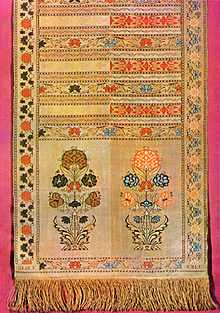Pas kontuszowy
.jpg)

Pas kontuszowy ("kontusz sash" or the Slutsk sash) was a cloth sash used for compassing a kontusz (a robe-like garment). It was one of the most distinctive items of male dress of Polish and Lithuanian nobility (szlachta) from about 17th through the 19th centuries. In an earlier periods, sometimes narrower sashes of fine cloth or silk net were worn, but the wide kontusz sash is specific to the later period.
Like the rest of Polish national dress, the kontusz sash was of eastern origin. It comprised a 3- to 4.5-meter-long strip of fabric covered with varied designs, around 40 cm wide. Luxurious sashes were made with silk and gold. Depending on the sash's width, it might be folded a number of ways so as to reveal various designs on various occasions, the most ornate sashes were considered to have four sides.
Initially such sashes were imported from Persia and Turkey. In the 17th century several sash manufactories were founded at places all over Rzeczpospolita, such as Kobyłka, Lipków, Hrodna, Kraków and Gdańsk. The largest and most notable manufacturies, however, were at Slutsk. Sashes produced there were considered the most desirable and were also the most expensive. Because of the popularity of the pas kontuszowy produced there, it was sometimes called pas słucki (Slutsk sash), regardless of the actual place of origin. Slutsk (city of Slutsk) sashes had two different color patterns on each side. A modern Polish poet and a singer, Jacek Kaczmarski, has sung about those sashes in one of his ballads, Z pasa słuckiego pożytek (The uses of a Slutsk sash).
See also
External links
| Wikimedia Commons has media related to Kontusz sashes. |
Further reading
- Maria Taszycka, Polskie pasy kontuszowe, Wyd. Literackie, 1985, ISBN 83-08-01039-3